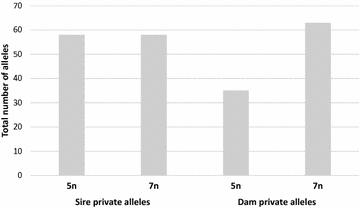The second highest chromosome count among vertebrates is observed in cultured sturgeon and is associated with genome plasticity
- PMID: 26867760
- PMCID: PMC4751722
- DOI: 10.1186/s12711-016-0194-0
The second highest chromosome count among vertebrates is observed in cultured sturgeon and is associated with genome plasticity
Abstract
Background: One of the five basal actinopterygian lineages, the Chondrostei, including sturgeon, shovelnose, and paddlefish (Order Acipenseriformes) show extraordinary ploidy diversity associated with three rounds of lineage-specific whole-genome duplication, resulting in three levels of ploidy in sturgeon. Recently, incidence of spontaneous polyploidization has been reported among cultured sturgeon and it could have serious negative implications for the economics of sturgeon farming. We report the occurrence of seven spontaneous heptaploid (7n) Siberian sturgeon Acipenser baerii, which is a functional tetraploid species (4n) with ~245 chromosomes. Our aims were to assess ploidy level and chromosome number of the analysed specimens and to identify the possible mechanism that underlies the occurrence of spontaneous additional chromosome sets in their genome.
Results: Among 150 specimens resulting from the mating of a tetraploid (4n) A. baerii (~245 chromosomes) dam with a hexaploid (6n) A. baerii (~368 chromosomes) sire, 143 displayed a relative DNA content that corresponds to pentaploidy (5n) with an absolute DNA content of 8.98 ± 0.03 pg DNA per nucleus and nuclear area of 35.3 ± 4.3 μm(2) and seven specimens exhibited a relative DNA content that corresponds to heptaploidy (7n), with an absolute DNA content of 15.02 ± 0.04 pg DNA per nucleus and nuclear area of 48.4 ± 5.1 μm(2). Chromosome analyses confirmed a modal number of ~437 chromosomes in these heptaploid (7n) individuals. DNA genotyping of eight microsatellite loci followed by parental assignment confirmed spontaneous duplication of the maternal chromosome sets via retention of the second polar body in meiosis II as the mechanism for the formation of this unusual chromosome number and ploidy level in a functional tetraploid A. baerii.
Conclusions: We report the second highest chromosome count among vertebrates in cultured sturgeon (~437) after the schizothoracine cyprinid Ptychobarbus dipogon with ~446 chromosomes. The finding also represents the highest documented chromosome count in Acipenseriformes, and the first report of a functional heptaploid (7n) genome composition in sturgeon. To our knowledge, this study provides the first clear evidence of a maternal origin for spontaneous polyploidization in cultured A. baerii. To date, all available data indicate that spontaneous polyploidization occurs frequently among cultured sturgeons.
Figures



Similar articles
-
Fertility of a spontaneous hexaploid male Siberian sturgeon, Acipenser baerii.BMC Genet. 2014 Jan 10;15:5. doi: 10.1186/1471-2156-15-5. BMC Genet. 2014. PMID: 24410899 Free PMC article.
-
Artificial whole genome duplication in paleopolyploid sturgeons yields highest documented chromosome number in vertebrates.Sci Rep. 2020 Nov 12;10(1):19705. doi: 10.1038/s41598-020-76680-4. Sci Rep. 2020. PMID: 33184410 Free PMC article.
-
Ploidy Levels and Fitness-Related Traits in Purebreds and Hybrids Originating from Sterlet (Acipenser ruthenus) and Unusual Ploidy Levels of Siberian Sturgeon (A. baerii).Genes (Basel). 2020 Oct 2;11(10):1164. doi: 10.3390/genes11101164. Genes (Basel). 2020. PMID: 33023081 Free PMC article.
-
Distant hybridization leads to different ploidy fishes.Sci China Life Sci. 2010 Apr;53(4):416-25. doi: 10.1007/s11427-010-0057-9. Epub 2010 May 7. Sci China Life Sci. 2010. PMID: 20596907 Review.
-
Evolutionary plasticity of acipenseriform genomes.Chromosoma. 2016 Sep;125(4):661-8. doi: 10.1007/s00412-016-0609-2. Epub 2016 Jul 14. Chromosoma. 2016. PMID: 27411693 Review.
Cited by
-
Examination of white blood cell indicators for three different ploidy level sturgeon species reared in an indoor recirculation aquaculture system for one year.Vet Med (Praha). 2022 Jan 6;67(3):138-149. doi: 10.17221/215/2020-VETMED. eCollection 2022 Mar. Vet Med (Praha). 2022. PMID: 39170595 Free PMC article.
-
ChromTR: chromosome detection in raw metaphase cell images via deformable transformers.Front Med. 2024 Dec;18(6):1100-1114. doi: 10.1007/s11684-024-1098-y. Epub 2024 Dec 7. Front Med. 2024. PMID: 39643800
-
Vertebrate Genome Evolution in the Light of Fish Cytogenomics and rDNAomics.Genes (Basel). 2018 Feb 14;9(2):96. doi: 10.3390/genes9020096. Genes (Basel). 2018. PMID: 29443947 Free PMC article. Review.
-
Ancient Sturgeons Possess Effective DNA Repair Mechanisms: Influence of Model Genotoxicants on Embryo Development of Sterlet, Acipenser ruthenus.Int J Mol Sci. 2020 Dec 22;22(1):6. doi: 10.3390/ijms22010006. Int J Mol Sci. 2020. PMID: 33374934 Free PMC article.
-
Genomic and Epidemiological Investigations Reveal Chromosomal Integration of the Acipenserid Herpesvirus 3 Genome in Lake Sturgeon Acipenser fulvescens.Viruses. 2025 Apr 5;17(4):534. doi: 10.3390/v17040534. Viruses. 2025. PMID: 40284977 Free PMC article.
References
-
- Ohno S. Evolution by gene duplication. Berlin: Springer; 1970.
Publication types
MeSH terms
Substances
LinkOut - more resources
Full Text Sources
Other Literature Sources

